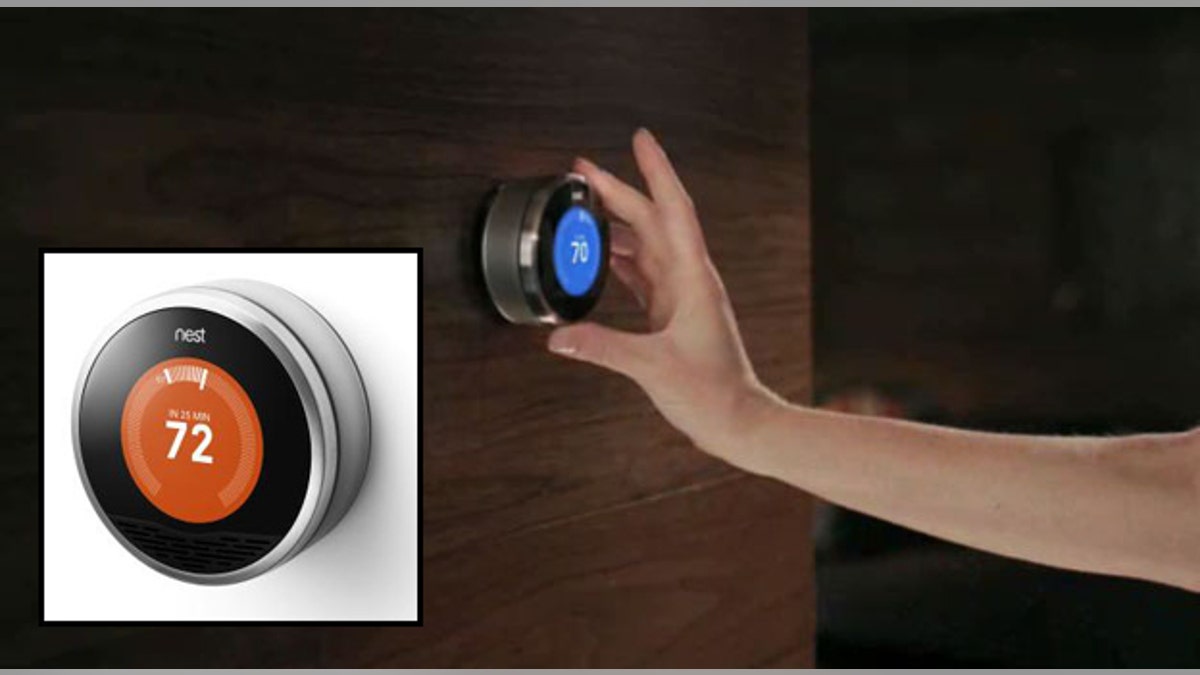
The world's first learning thermostat, created by Tony Fadell -- the man who sold Steve Jobs on the iPod -- may help lower your heating bill. (NEST Labs)
Can the father of the iPod make saving energy sexy?
Tony Fadell is the man who took the idea of the iPod to Steve Jobs, spawning a renaissance at the company and then overseeing successive products, including the first iPhones. He officially left the company last year (after a stint in a consulting role) to pursue green technologies, and today he's ready with his first introduction.
Dubbed Nest Labs, his post-Apple debut is a home thermostat. Yes, a thermostat.
What's different is that Nest looks like the kind of slick gadget that you'd want to display on your coffee table. Its brushed metal fascia reflects the colors around it, and the sky blue digital display is elegant, yet high tech. It's designed to go on your wall and replace that old-fashioned, mercury-filled Honeywell model we all grew up with. But Nest has a rotating push-in dial (sound familiar?) that makes you want to touch it -- even though after it learns your habits you may never have to.
"I wanted it to be something that draws attention," Fadell told me over lunch before the launch.
Nest certainly does. But it's more than just a pretty face. It's smart, too.
It neatly solves several problems that have bedeviled home owners who have been trying to save energy -- and money -- for years but been thwarted by either awkward technology or expensive home automation systems.
One problem is the second home/country home/away from home issue. If you're not there, why heat or completely cool the house? But of course, you've got to remember to change the thermostat or program it. I've installed programmable thermostats. They're clunky and about as easy to use as a mainframe computer from the 50s.
Nest takes a different approach by learning when you turn it up and down, understanding your preferred settings at particular times of the day, and then after a week or so starting to make those changes on its own. It even has a motion sensor so that if no one walks by it after a couple of hours, it will switch into "away" mode, and turn down the heat or the AC, according to presets. (Of course, you can turn it back up, and it will learn to stay on longer, too.)
Current programmable thermostats can be set for a week, but they don't learn your family's habits or watch for movement. They also aren't automatically connected to the Internet.
Nest has built-in Wi-Fi so that it can connect to a home network. It can then be set or adjusted remotely from anywhere, including an iPhone or Android-based smartphone. To warm up or cool down the house before you get there, simply tap a few settings from your phone before you leave the office -- or while you're on the way there.
Fadell also considered other issues with existing programmable thermostats: They usually require power (something the old ones don't) and aren't compatible with forthcoming smart meters from the power companies. Nest has a built-in rechargeable battery that receives a trickle charge from existing wires (no new wiring needed) and it has the de facto communications standard that power companies are using built in. And most people should be able to install Nest in about 20 minutes.
How much energy or money could you save? The U.S. Department of Energy says a typical home owner saves about 10 percent with a standard programmable thermostat. Fadell thinks Nest can do better, by shaving 20 to 30 percent off some people's energy bills. That's several hundred dollars or more a year for most of us, which should justify Nest's $249 price tag.
Nest will go on sale in November, available not just in hardware stores but from electronics stores like BestBuy, which also sets it apart from other solutions. Unlike other home energy focused tech companies, such as Tendril and Opower, Nest is reaching out directly to consumers. You don't even have to go to a hardware store.
Fadell thinks there's a huge market for Nest. According to the CEO, there are about 150 million thermostats in American homes, 60 percent of which are manual thermostats. Roughly 10 million are swapped out or installed each year, many for digital thermostats these days. (Not exactly iPod market numbers, but still serious business.)
Even those people who already have electronic thermostats could benefit from a smarter gadget, however: Nest's device is the first to learn your habits and alter itself, after all.
While iPods and iPhones are wonderful devices, Fadell says he wanted to make a more meaningful difference by bringing similar technology to the green market. With Nest he may succeed in doing exactly that, applying slick, high-tech, easy-to-use solutions to the dull world of heating and air-conditioning.
And he hints, there's more to come.
Follow John R. Quain on Twitter @jqontech or find more tech coverage at J-Q.com.
